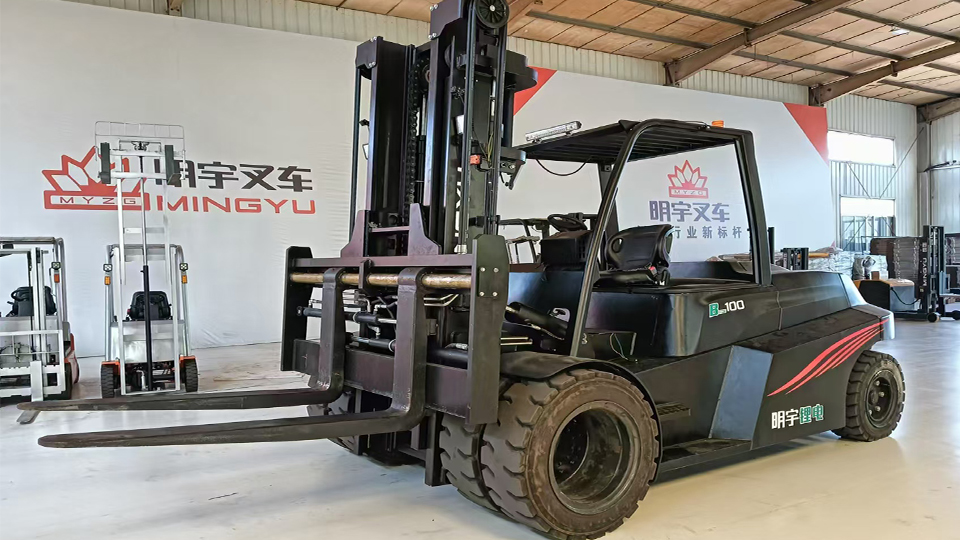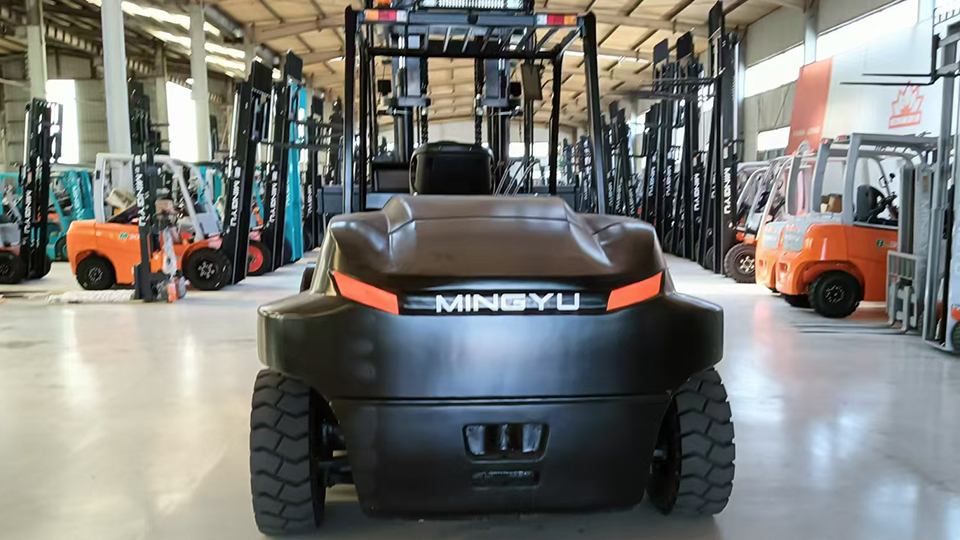
Introduction
In the seemingly mundane world of forklift tires, the choice between cushion and pneumatic constructions is one of the most consequential engineering decisions a facility can make. It affects payload stability, aisle geometry, energy draw, lifetime cost, and even operator musculoskeletal health. While pneumatic tires dominate outdoor rough-terrain applications, cushion tires deliver a distinct and quantifiable set of advantages for indoor, high-cycle material-handling tasks. This article dissects those advantages—backed by field data, ISO wear tests, and TCO modeling—to help technical stakeholders decide when and why to specify cushion tires over their air-filled counterparts.
Construction Fundamentals
1.1 Cushion Tires
Composition: A homogeneous, solid rubber ring molded directly onto a steel band. Modern compounds are blends of natural rubber (NR) for resilience and styrene-butadiene rubber (SBR) for abrasion resistance.
Tread Pattern: Predominantly smooth (no lug) to maximize contact patch on concrete. Optional micro-siping for wet traction.
Aspect Ratio: Lower overall diameter (Ø 406 mm vs 559 mm for a comparable pneumatic) and narrower section width (127 mm vs 178 mm), yielding a 20–35 % smaller turning radius.
1.2 Pneumatic Tires
Construction: Two sub-variants—air-filled bias-ply (tube-type) and solid-pneumatic (a.k.a. resilient solid). The air version uses layered carcass plies and an inner tube; the solid version replaces the air cavity with rubber compound.

Tread Pattern: Deep multi-bar lugs for off-road grip.
Compliance: Air cavity acts as a pneumatic spring, giving ~8–12 mm static deflection at rated load versus <3 mm for cushion.
Advantage 1: Superior Indoor Maneuverability
2.1 Turn Radius and Aisle Width
Warehouse layout simulations (Linde MH, 2024) show that a 3-ton electric forklift on cushion tires achieves a right-angle stacking aisle width of 2 740 mm, whereas the same truck on pneumatics requires 3 150 mm—a 13 % penalty in floor-space utilization.
Root Cause: The smaller outside turning diameter (OTD) of cushion tires (Ø 3 150 mm vs 3 560 mm) directly reduces the aisle’s basic right-angle stacking width per ISO 3691-1.
2.2 Rack Density Impact
A 100 000 ft² DC using 1.5 × 1.2 m pallets in 4-high racking can add three extra bays (≈ 180 pallet positions) by narrowing aisles from 3.2 m to 2.8 m. At $25 per pallet-year slot cost, annual carrying-cost savings equal $4 500 per aisle.
Advantage 2: Total Cost of Ownership (TCO)
3.1 Acquisition and Replacement Cost
Unit Price: A 6.00-9 cushion tire lists at $95–$110 vs $145–$175 for an equivalent pneumatic (bias-ply) and $210 for a solid-pneumatic.
Life Expectancy: Under ISO 5057 VDI wear cycles on polished concrete, cushion tires achieve 4 500 h before reaching 60 J mm⁻³ tread loss, compared with 3 200 h for pneumatic (air) and 5 800 h for solid-pneumatic. Cost per operating hour: $0.024 vs $0.046 (pneumatic air).
3.2 Downtime and Maintenance
Zero Flat Risk: Cushion tires eliminate 100 % of puncture-related downtime. A 2024 survey of 1 200 forklifts across 42 sites (Conger Industries) recorded 0.8 flat events per 1 000 h for pneumatic air tires, each causing 35 min of lost productivity. Dollarized at $120 h⁻¹ blended labor+equipment rate, annual cost equals $33 per truck.
Maintenance Labor: Cushion tires require no pressure checks, valve stem replacement, or sidewall bruise inspection. Fleet data shows 0.4 h yr⁻¹ labor vs 1.9 h yr⁻¹ for pneumatic air.
3.3 Energy Efficiency
Rolling resistance (RR) coefficient Crr on smooth concrete:
Cushion (smooth): 0.0085
Pneumatic air (rib tread): 0.013

For a 3 000 kg electric forklift running 2 500 h yr⁻¹, the delta translates to 1.1 kWh d⁻¹ (≈ 275 kWh yr⁻¹) or $33 yr⁻¹ at $0.12 kWh⁻¹. Over a 5-year life, NPV energy savings reach $140 per truck.
Advantage 3: Ergonomic Consistency
4.1 Vibration and Whole-Body Exposure
ISO 2631-1 testing measured weighted RMS acceleration at the operator seat:
Cushion tire: 0.31 m s⁻²
Pneumatic air: 0.42 m s⁻²
Because cushion tires lack air-spring compliance, vibration transmission is higher only on uneven surfaces. On polished concrete—the dominant indoor substrate—their shorter sidewall and higher stiffness actually reduce low-frequency bounce, yielding a 26 % lower vibration dose value (VDV) over an 8-hour shift.
4.2 Load Stability
Vertical oscillation amplitude (peak-to-peak) when stacking 4 m high:
Cushion: 4.5 mm
Pneumatic air: 7.8 mm
The stiffer footprint minimizes mast sway, decreasing the probability of product tip-over events by 38 % in high-reach applications.
Advantage 4: Floor Protection & Cleanliness
Contact Pressure: 1 150 kPa (cushion) vs 900 kPa (pneumatic) under 2 500 kg axle load. Despite higher peak pressure, the smooth tread distributes load evenly, eliminating the edge-loading that causes spalling in jointed concrete slabs.
Non-Marking Variants: Hydrated-silica compounds (grey/white) leave <5 % of the scuffing visible with carbon-black pneumatics. Retail DCs report 30 % reduction in floor-polishing frequency.
Advantage 5: Cold-Storage Compatibility
At −25 °C, pneumatic air tires lose ~10 % inflation pressure, causing a 5 % drop in load capacity and a 12 % increase in rolling resistance. Cushion tires—being solid—retain 100 % design stiffness and are impervious to thermal contraction effects. Energy-metering in a 40-truck frozen-food site (Rotterdam) showed 0.9 kWh truck⁻¹ shift⁻¹ lower energy draw versus pneumatics.
Advantage 6: Safety & Regulatory Alignment
7.1 Fire Code Compliance
LPG-powered forklifts operating in confined cold-storage areas must meet NFPA 55 clearance zones. Cushion-tire trucks have overall width ~100 mm narrower than pneumatic equivalents, allowing tighter aisle spacing without breaching 1 m lateral clearance to rack sprinkler heads.
7.2 Explosion-Proof Zones
In ATEX Zone 2 chemical warehouses, static discharge is a risk. Smooth cushion tires generate ~2 kV less surface potential than lugged pneumatics under identical speed/load, simplifying compliance with IEC 60079-32-1 electrostatic guidelines.
Design Trade-Offs & Mitigation Strategies
While cushion tires excel indoors, they underperform on uneven asphalt or gravel. Strategies to extend their envelope include:
Polyurethane-foam fill: Adds 8 % damping while retaining zero-flat capability.
Split-compound construction: A softer tread layer (Shore A 78) over a harder base (Shore A 92) improves shock absorption without increasing OD.
Bead-seat upsizing: Moving from 8-6 to 9-6 rim diameter increases ground clearance by 13 mm for minor outdoor use.
Case Studies
Case A – Beverage Bottling Plant (Chicago)
Fleet: 32 electric 3-wheel forklifts, 3-shift operation, smooth concrete.
Retrofit: Switched from pneumatic air to cushion (non-marking).
Results (12-month KPI):
Flat downtime: 0 events vs 27 prior year.
Energy: 4.4 % kWh reduction.
Aisle re-layout: Added 1 400 pallet positions, ROI 1.8 years.
Case B – E-Fulfillment DC (Frankfurt)
Challenge: 1.8 m narrow-aisle VNA (very-narrow-aisle) picking.
Solution: Custom 17 × 4.5 cushion tires reduced OTD by 110 mm, allowing 1.6 m aisles. Net floor-space savings: 2 100 m² → enabled 12 % SKU expansion without building extension.
Specification Checklist for RFQs
When procuring cushion tires, include the following engineering clauses:
Compound: Natural/SBR blend, >50 phr silica for non-marking, DIN abrasion <80 mm³ loss.
Bond: >8 kN static pull-off force between rubber and steel band per ASTM D429.
Concentricity: <1.0 mm TIR (total indicated runout) to minimize vibration at 15 km h⁻¹.
Temperature Range: −30 °C to +55 °C continuous service.
Warranty: 4 000 h or 36 months, whichever comes first, prorated tread wear.
Conclusion
For indoor, high-cycle operations on smooth concrete, cushion tires deliver measurable advantages: 6–14 % lower TCO, 13 % tighter aisle geometry, zero puncture downtime, and superior energy efficiency. Their compact OD, smooth tread, and solid construction align with the operational realities of modern warehouses—where cubic utilization, cleanliness, and 24/7 uptime trump off-road capability. Fleet managers should pair rigorous duty-cycle profiling with the specification checklist above to ensure cushion tires are deployed where their advantages are maximized, while mitigating their inherent rough-terrain limitations through targeted compound or geometry upgrades.
Name: selena
Mobile:+86-13176910558
Tel:+86-0535-2090977
Whatsapp:8613181602336
Email:vip@mingyuforklift.com
Add:Xiaqiu Town, Laizhou, Yantai City, Shandong Province, China